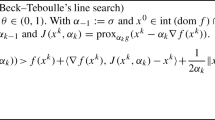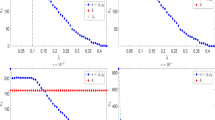Abstract
This paper deals with the non-uniqueness of the solutions of an analysis—Lasso regularization. Most previous works in this area are concerned with the case, where the solution set is a singleton, or to derive guarantees to enforce uniqueness. Our main contribution consists in providing a geometrical interpretation of a solution with a maximal analysis support: such a solution abides in the relative interior of the solution set. Our result allows us to provide a way to exhibit a maximal solution using a primal-dual interior point algorithm.


Similar content being viewed by others
References
Chen, S.S., Donoho, D.L., Saunders, M.A.: Atomic decomposition by basis pursuit. SIAM J. Sci. Comput. 20(1), 33–61 (1999)
Mallat, S.G.: A wavelet tour of signal processing, 3rd edn. Academic Press, Amsterdam (2009)
Tibshirani, R.: Regression shrinkage and selection via the Lasso. J. R. Stat. Soc. Ser. B. Methodol. 58(1), 267–288 (1996)
Elad, M., Milanfar, P., Rubinstein, R.: Analysis versus synthesis in signal priors. Inverse Probl. 23(3), 947 (2007)
Vaiter, S., Peyré, G., Dossal, C., Fadili, M.J.: Robust sparse analysis regularization. IEEE Trans. Inf. Theory 59(4), 2001–2016 (2013)
Nam, S., Davies, M.E., Elad, M., Gribonval, R.: The cosparse analysis model and algorithms. Appl. Comput. Harmon. Anal. 34(1), 30–56 (2013)
Rudin, L., Osher, S., Fatemi, E.: Nonlinear total variation based noise removal algorithms. Phys. D 60(1), 259–268 (1992)
Steidl, G., Weickert, J., Brox, T., Mrázek, P., Welk, M.: On the equivalence of soft wavelet shrinkage, total variation diffusion, total variation regularization, and sides. SIAM J. Numer. Anal. 42(2), 686–713 (2004)
Tibshirani, R., Saunders, M., Rosset, S., Zhu, J., Knight, K.: Sparsity and smoothness via the fused Lasso. J. R. Stat. Soc. Ser. B. Stat. Methodol. 67(1), 91–108 (2005)
Zhang, H., Yin, W., Cheng, L.: Necessary and sufficient conditions of solution uniqueness in 1-norm minimization. J. Optim. Theory Appl. 164(1), 109–122 (2015)
Zhang, H., Yan, M., Yin, W.: One condition for solution uniqueness and robustness of both l1-synthesis and l1-analysis minimizations. arXiv preprint arXiv:1304.5038 (2013)
Gilbert, J.C.: On the solution uniqueness characterization in the \(\ell ^1\) norm and polyhedral gauge recovery. Technical report, INRIA Paris-Rocquencourt (2015)
Tibshirani, R.J.: The lasso problem and uniqueness. Electron. J. Stat. 7, 1456–1490 (2013)
Natarajan, B.K.: Sparse approximate solutions to linear systems. SIAM J. Comput. 24(2), 227–234 (1995)
Mallat, S.G., Zhang, Z.: Matching pursuits with time–frequency dictionaries. IEEE Trans. Signal Process. 41(12), 3397–3415 (1993)
Pati, Y.C., Rezaiifar, R., Krishnaprasad, P.S.: Orthogonal matching pursuit: recursive function approximation with applications to wavelet decomposition. In: Conference on Signals, Systems and Computers, pp. 40–44. IEEE (1993)
Needell, D., Tropp, J.A.: CoSaMP: iterative signal recovery from incomplete and inaccurate samples. Appl. Comput. Harmon. Anal. 26(3), 301–321 (2009)
Attouch, H., Cominetti, R.: \(l^p\) approximation of variational problems in \(l^1\) and \(l^\infty \). Nonlinear Anal. TMA 36(3), 373–399 (1999)
Rockafellar, R.: Convex Analysis, vol. 28. Princeton University Press, Princeton (1996)
Frisch, K.R.: The logarithmic potential method of convex programming. Technical report, University Institute of Economics, Oslo, Norway (1955)
Barbara, A.: Strict quasi-concavity and the differential barrier property of gauges in linear programming. Optimization 64(12), 2649–2677 (2015)
Barbara, A., Crouzeix, J.P.: Concave gauge functions and applications. Math. Methods OR 40(1), 43–74 (1994)
Roos, C., Terlaky, T., Vial, J.P.: Interior Point Methods for Mathematical Programming. Wiley, New York (2009)
Mehrotra, S.: On the implementation of a primal-dual interior point method. SIAM J. Optim. 2(4), 575–601 (1992)
Author information
Authors and Affiliations
Corresponding author
Additional information
Communicated by Asen L. Dontchev.
Appendix
Appendix
In this section, we propose to express some of our results in a general framework. More precisely, we consider the following optimization problem
where E is a Banach space, \(f, g : E\mapsto {\mathbb {R}}\cup \{+\infty \}\) are convex lower semicontinuous functions. The dual space of E and the pairing between E and \(E^*\) will be denoted by \(E^*\) and \(\langle \cdot , \cdot \rangle \), respectively. The Fenchel subdifferential of f at \({\bar{x}}\) is defined by
The aim of the following proposition is to give a characterization of solutions of the problem (14).
Proposition A.1
Let \({\bar{x}}\in E\) be a fixed solution of the problem (14) and \(x^*\in \partial g({\bar{x}})\) be such that \(-x^* \in \partial f({\bar{x}})\). Then the following assertions are equivalent:
-
(1)
u is a solution of the problem (14),
-
(2)
\(g(u) \le g({\bar{x}}) + \langle x^*, u-{\bar{x}}\rangle \) and u is a solution of the problem
$$\begin{aligned} \min _{x\in E} \{f(x) +\langle x^*, x\rangle \}. \end{aligned}$$(15)
Consequently, if \(\{ x\in E : \, g(x) \le g({\bar{x}}) + \langle x^*, x-{\bar{x}}\rangle \}\) is a polyhedral set and the function f is polyhedral (supremum of a finite affine family), then so is \(\underset{x \in {\mathbb {R}}^n}{{{\mathrm{Argmin}}}}\;\{f(x)+g(x)\}\).
Proof
Since the implication \((2) \Longrightarrow (1)\) is obvious, we will establish only the implication \((1) \Longrightarrow (2)\). First note that, because of our assumptions, assertion (2) is equivalent to say that \(x^*\in \partial g(u)\) and \(-x^*\in \partial f(u)\). So if u is a solution of the problem (14), we have
Since \(x^*\in \partial g({\bar{x}})\) and \(-x^*\in \partial f({\bar{x}})\), we easily obtain, by using relation (16), that \(x^*\in \partial g(u)\) and \(-x^*\in \partial f(u)\) and the proof is completed. \(\square \)
A particular and interesting case is the Hilbert setting with a special form of g.
Corollary A.1
Suppose that E (resp. F) is a Hilbert endowed with a scalar product denoted by \(\langle \cdot , \cdot \rangle \) and the associated norm \(\Vert \cdot \Vert \). Let \({\varPhi }: E\mapsto F\) be a linear continuous operator and \(y\in F\). Define the function \(g : E \mapsto {\mathbb {R}}\) by
Let \({\bar{x}}\in E\) be a fixed solution of the problem (14) and put \(x^* = {\varPhi }^*({\varPhi }{\bar{x}}-y)\). Then the following assertions are equivalent:
-
(1)
u is a solution of the problem (14),
-
(2)
\({\varPhi }u={\varPhi }{\bar{x}}\) and u is a solution of the problem
$$\begin{aligned} \min _{x\in E} \{f(x) +\langle x^*, x\rangle \}. \end{aligned}$$(17)
Consequently, each solution u of the problem (14) satisfies \({\varPhi }u={\varPhi }{\bar{x}}\) and \(f(u) = f({\bar{x}})\).
Proof
It suffices to see that the (in)equality \(g(u) \le g({\bar{x}}) + \langle x^*, u-{\bar{x}}\rangle \) is equivalent to \({\varPhi }u={\varPhi }{\bar{x}}\) and to apply Proposition A.1. \(\square \)
The following corollary asserts that knowing one solution of (14), we can determine all the other ones.
Corollary A.2
Let the assumptions of Corollary A.1 be satisfied. Then
Rights and permissions
About this article
Cite this article
Barbara, A., Jourani, A. & Vaiter, S. Maximal Solutions of Sparse Analysis Regularization. J Optim Theory Appl 180, 374–396 (2019). https://doi.org/10.1007/s10957-018-1385-3
Received:
Accepted:
Published:
Issue Date:
DOI: https://doi.org/10.1007/s10957-018-1385-3




